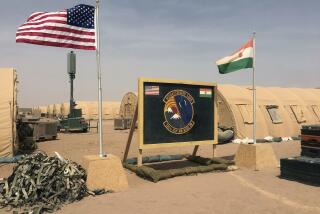Close Subic Base by End of ‘92, Manila Tells U.S.
- Share via
MANILA — The Philippine government served notice today that the United States must close its largest naval base in Asia by the end of 1992, ending nearly a century of American military presence in this former colony.
The eviction notice came in the form of a statement from President Corazon Aquino’s top aide after the last in a series of negotiations to extend the U.S. presence at Subic Bay Naval Base broke down during a morning meeting between Aquino and U.S. Ambassador Frank Wisner. There had earlier been proposals to extend the lease for three years.
“Today, the governments of the Philippines and the United States have mutually agreed to terminate discussions on a proposed three-year executive agreement for a phased and orderly withdrawal of U.S. forces stationed at the Subic Naval Base,” said Aquino’s executive secretary, Franklin Drilon.
A key issue in the talks was a Philippine constitutional ban on nuclear weapons at the base. U.S. policy is to refuse to confirm or deny the presence of such weapons on ships or aircraft.
“Unfortunately, the U.S. cannot meet these Philippine concerns,” declared Drilon in the prepared statement after the morning session ended in failure.
Drilon stressed that Manila wants to maintain good relations with Washington. However, he made it clear that Aquino, who appeared to favor Washington’s attempts to extend the bases agreement another three years, could not find a constitutional way around September’s vote by the Philippine Senate rejecting a full 10-year extension in exchange for $203 million in aid.
“The friendly and cordial relations between the United States and the Philippines will continue,” Drilon said. “Both governments will continue to build on this strong bond of friendship between the two countries.”
The formal eviction order for Subic, which Drilon indicated will be formally served Tuesday, had been expected for several weeks. In addition to the nuclear issue, Washington had insisted that under a three-year phase-out agreement, the U.S. Navy must be given free and unhindered use of the massive base and that it be permitted to set its own timetable for withdrawal.
In assessing the recent U.S. stubbornness, several Western military analysts said it appeared that Washington was biding its time until after next year’s presidential and legislative elections, which are scheduled to take place here in late May. A new government and Senate will take office in Manila on June 30, and the analysts said Washington was hoping that the new administration and legislature would be more flexible in negotiating an extension.
Drilon himself indicated during his meeting with the media today that any extension of the U.S. presence at Subic Bay or of the pullout timetable would be the prerogative of the next government in power. Still, the announcement made it clear that Manila expects all U.S. forces to be out of Subic Bay before Dec. 31, 1992.
Although the numbers have varied, the 60,000-acre base 50 miles west of Manila recently had about 5,800 troops and 4,500 dependents. Subic has been the Navy’s major supply and repair facility in the western Pacific. It provides logistic support for 7th Fleet operations in the Pacific and Indian Ocean.
Closing of the base will cost thousands of Filipinos their jobs. Most of the 300,000 residents of Olongapo, adjacent to Subic, rely on the base for their livelihood. In June, eruptions from nearby Mt. Pinatubo devastated the economy of Zambales province, the home of Subic Bay.
The volcano’s eruption also forced the U.S. Air Force vacate its sprawling Clark Air Base from nearby Angeles City, and in November, it was formally shut down. The four other U.S. bases in the Philippines have also been vacated this year.
New Delhi correspondent Fineman is on assignment in the Philippines.
More to Read
Sign up for Essential California
The most important California stories and recommendations in your inbox every morning.
You may occasionally receive promotional content from the Los Angeles Times.













